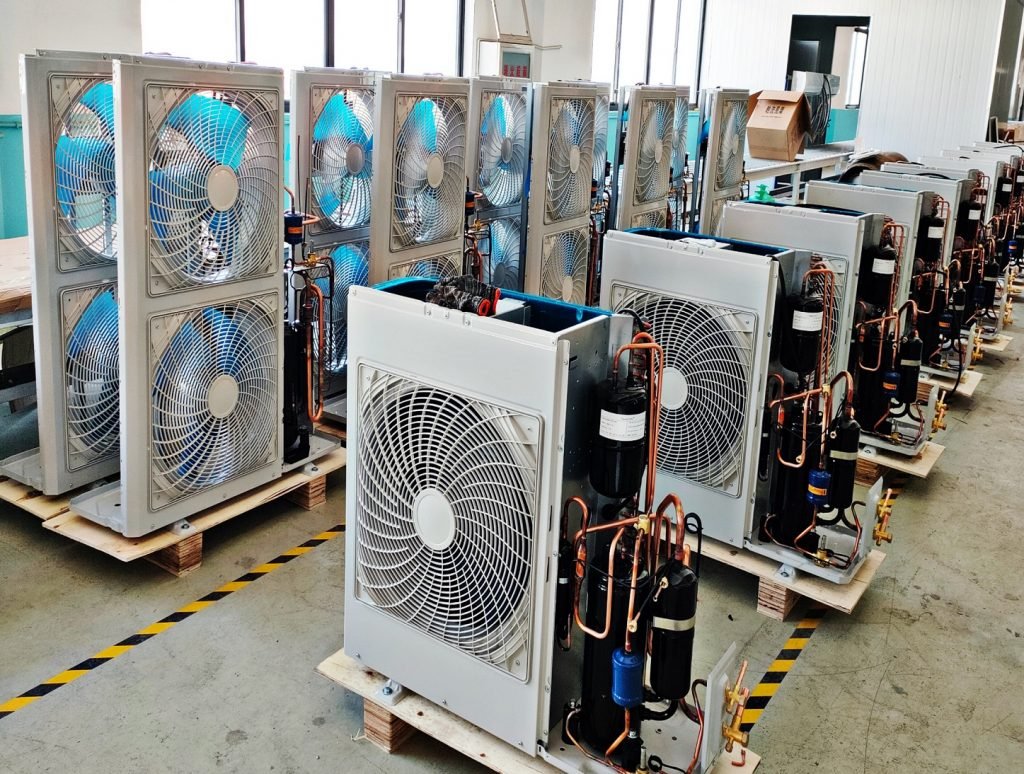El sistema de refrigeración es un sistema de ciclo complejo compuesto por componentes clave como compresor, condensador, válvula de expansión, y evaporador. Estos componentes trabajan juntos para lograr el enfriamiento a través de la circulación del refrigerante..
Sin embargo, Cuando el aire ingresa a este sistema cerrado, Puede causar problemas de serie que afectan su funcionamiento normal. Por lo tanto, es crucial comprender las causas, distribución, peligros, y métodos de eliminación de intrusión del aire en sistemas de refrigeración.
Causas de aire en el sistema de refrigeración
A pesar de sistemas de refrigeración son ciclos sellados donde el aire no debe ingresar, El aire aún puede infiltrarse debido a varias razones.
A continuación se muestra un análisis detallado de estas causas:
1.Aspiración incompleta durante la instalación o mantenimiento
–La aspiradora es crítica para eliminar el aire y la humedad durante la instalación o el mantenimiento. El bajo rendimiento de la bomba de vacío o el tiempo de aspiración insuficiente pueden dejar aire en el sistema.
–Los operadores o problemas de equipos sin experiencia también pueden dar lugar a una aspiradora incompleta.
2. Aire introducido durante la adición de refrigerante
–Procedimientos incorrectos, tales como contenedores de refrigerante sin sellar o mangueras conectadas incorrectamente, puede permitir que el aire ingrese al sistema durante refrigerante suma.
–Los métodos de llenado abiertos aumentan la probabilidad de ingresar aire.
3. Fuga del sistema
–Los puntos de fuga en el sistema pueden dejar entrar el aire, Particularmente si los dos altos & Los lados de baja presión tienen fugas. Las diferencias de presión facilitan la intrusión del aire.
–La fuga a menudo ocurre en las conexiones de la tubería, sellos de válvula, o sellos de compresor.
4. Use refrigerantes de calidad inferior o contenedores sin sellar
–Los refrigerantes de calidad inferior pueden contener impurezas o humedad, Introducir el aire en el sistema.
–Los contenedores mal sellados permiten que el aire se mezcle con refrigerantes y posteriormente ingrese al sistema.
5. Falta de eliminación de aire durante la operación a largo plazo
–Con el tiempo, El aire puede infiltrarse lentamente en el sistema., especialmente con fluctuaciones de presión significativas.
–La negligencia del operador o el mal funcionamiento del equipo de eliminación de aire pueden provocar acumulación de aire..
6. Penetración del aire atmosférico
Si la presión de funcionamiento del sistema es inferior a la presión atmosférica, El aire puede filtrarse en el sistema a través de huecos en las válvulas., compresores, o conexiones no soldadas.
7. Descomposición del aceite lubricante
Alguno aceites lubricantes, como los aceites minerales, Puede descomponerse en condiciones de trabajo complejas., liberando hidrocarburos que se mezclan con el refrigerante.
Distribución de aire en el sistema de refrigeración
1. Lugares de acumulación natural
El aire es más ligero que refrigerantes y tiende a acumularse en puntos altos del sistema., como:
Condensador: A menudo se instala en una posición alta del sistema., convirtiéndolo en un punto común de acumulación de aire.
Receptor: Otro punto alto donde el aire se acumula fácilmente..
Acumulador: Ciertos sistemas ver el aire acumulando aquí.
Secciones altas de tuberías: Cualquier sección de tubería elevada puede convertirse en una ubicación para la acumulación de aire.
2. Movimiento del aire en el sistema
El aire puede disolverse en el refrigerante y moverse a través del sistema durante la operación, afectar varios componentes.
3. Impacto del diseño del sistema en la distribución del aire
—Diseños de tuberías complejas: Aumentar las áreas potenciales para la acumulación de aire.
—Diferencias de altura: Las grandes variaciones de altura en el sistema pueden conducir a aire concentrado en puntos más altos.
Peligros de aire en el sistema de refrigeración
1. Aumentar el consumo de energía
El aire consiste principalmente en nitrógeno y oxígeno, que son gases no condensables. La acumulación de aire en el lado de alta presión aumenta la presión del sistema, forzar el compresor trabajar más duro, aumentar el consumo y el desgaste de la energía, y acortar la vida del compresor.
2. Inducir reacciones químicas
La humedad del aire puede reaccionar con refrigerantes, especialmente en sistemas de aceite mineral, producir sustancias ácidas que corroen los componentes metálicos internos, provocando fugas y daños.
3. Reducir la eficiencia de enfriamiento
El aire en el condensador o evaporador puede causar «esclusas de aire,» obstruyendo el flujo de refrigerante y el intercambio de calor, reducir la eficiencia general del sistema.
4. Formar bloque de hielo
La humedad en el aire puede congelarse en los dispositivos de estrangulamiento. (p.ej., válvulas de expansión), causando bloqueos que interrumpen refrigerante fluir y puede dañar el equipo.
5. Afectar el rendimiento de la válvula de expansión
La presencia de aire puede distorsionar las lecturas de presión en la válvula de expansión., provocar una regulación inadecuada y un flujo de refrigerante inestable.
6. Problemas de lubricación del compresor
La humedad en el aire puede degradarse. aceite lubricante, reducir su efectividad y causar compresor desgaste o falla.
Métodos para eliminar el aire del sistema de refrigeración
1. Utilice mecanismos de liberación de aire diseñados por el sistema
Muchos sistemas de refrigeración tener dispositivos de ventilación automáticos, como válvulas de ventilación ubicadas en la parte superior del condensador. Estos dispositivos pueden expulsar aire automáticamente durante el funcionamiento del sistema.. Para utilizar estos dispositivos para ventilación:
Ubique las válvulas de liberación de aire: A menudo en el punto más alto del condensador..
Liberación manual: Abra la válvula lentamente durante la operación para liberar aire mientras monitorea los manómetros para evitar refrigerante pérdida.
2. Método de extracción al vacío
Utilice una bomba de vacío para evacuar el sistema y eliminar eficazmente el aire y la humedad..
Preparar la bomba de vacío: Seleccione una bomba de vacío adecuada para la capacidad del sistema y asegúrese de que esté en buenas condiciones de funcionamiento..
Conecte la bomba de vacío: Conecte la bomba de vacío al puerto de vacío del sistema..
Proceso de evacuación: Inicie la bomba de vacío y continúe la evacuación hasta que la presión del sistema alcance el nivel de vacío especificado. Por lo general, es necesario mantener este nivel durante un tiempo para garantizar una extracción exhaustiva del aire y la humedad..
Verifique el nivel de vacío: Use un medidor de vacío para monitorear el nivel de vacío y asegurarse de que cumpla con los requisitos técnicos.
3. Liberación aérea manual
Cuando el sistema está en un estado de cierre, Abra manualmente la válvula de ventilación para liberar aire.
Localice la válvula de ventilación: Identificar la válvula de ventilación en el sistema, normalmente ubicado en el punto más alto.
Abra lentamente la válvula: Abra gradualmente la válvula de ventilación para liberar aire. Monitorear el flujo de refrigerante para evitar una pérdida significativa de refrigerante.
Repetir ventilación: Realizó múltiples operaciones de ventilación hasta que no aparezcan burbujas.
4. Liberación de aire a alta temperatura
Al aumentar el sistema temperatura, La humedad en el aire se evapora, Y luego se expulsa el aire.
Calentar el sistema: Use el equipo de calefacción para elevar la temperatura del sistema, haciendo que la humedad se evapore.
Aventar el aire: En condiciones de alta temperatura, expulsar el vapor de aire y agua a través de la válvula de ventilación.
Enfriar el sistema: Después de que el sistema se enfría, Verifique cualquier aire restante.
5. Usa desecantes
Agregue desecantes al sistema para absorber la humedad y reducir el impacto del aire.
Seleccione el desecante: Use desecantes adecuados para el tipo de refrigerante, como tamices moleculares.
Instale la secadora: Instalar un secadora en el sistema y reemplace el desecante regularmente.
6. Medidas preventivas
Verifique regularmente las fugas: Inspeccionar periódicamente el sellado del sistema para evitar la entrada de aire.
Agregue correctamente el refrigerante: Al agregar refrigerante, Asegúrese de que el contenedor esté sellado para evitar la mezcla de aire.
Mantener la integridad del sellado: Durante el mantenimiento e instalación, Asegúrese de que todas las conexiones estén correctamente selladas.
7. Seguridad y precauciones ambientales
Usar equipo de protección: Durante las operaciones de ventilación, Use guantes y gafas protectores para evitar quemaduras frías refrigerantes.
Evitar fugas de refrigerante: Adherirse a las regulaciones ambientales para evitar fugas de refrigerante que puedan dañar el medio ambiente.
Utilizar herramientas profesionales: Asegure el uso de herramientas y equipos apropiados para las operaciones de ventilación.
8. Verificar la efectividad de la ventilación
Prueba de presión: Monitorear la presión del sistema utilizando un medidor de presión para garantizar la estabilidad.
Observe el estado operativo: Después de la operación del sistema, Observe el efecto de enfriamiento y el rendimiento del compresor para garantizar que no hay anormalidades.
9. Problemas comunes
El sistema todavía no se enfría: Esto puede indicar aire residual u otras fallas, requiriendo reventing o mayor resolución de problemas.
Anormalidades de presión: Verifique si hay fugas del sistema o falla desecante.
Conclusión
Entrada de aire en sistemas de refrigeración es un problema importante que no se puede ignorar, ya que no solo afecta la eficiencia del sistema, sino que también puede acortar la vida útil del equipo. El aire puede ingresar al sistema durante la instalación, mantenimiento, fugas, o carga de refrigerante, acumulando principalmente en áreas altas como condensadores o cerca válvulas de expansión. Esto conduce a una eficiencia reducida, daño al compresor, bloqueo, y desequilibrios de presión.
Para resolver este problema, Este artículo presenta varios métodos para eliminar el aire, incluido el uso de las válvulas de ventilación del sistema, ventilación manual, ventilación de aspiradora, ventilación a alta temperatura, y usar desecantes para absorber la humedad. Además, Medidas preventivas como controles de fugas regulares, Carga de refrigerante adecuada, y mantener el sellado del sistema son cruciales.
En resumen, Eliminar oportunamente el aire del sistema es esencial para mantener un funcionamiento eficiente y prolongar la vida útil del equipo.. Si bien hay varios métodos disponibles para eliminar el aire, la prevención sigue siendo clave. A través de mantenimiento regular y prácticas de instalación adecuadas., puede garantizar el buen funcionamiento del sistema.
Para operadores de sistemas, La vigilancia contra la entrada de aire y la adopción de las medidas adecuadas son fundamentales para garantizar el funcionamiento estable a largo plazo de los sistemas de refrigeración.. Estos métodos y medidas preventivas no sólo mejoran la eficiencia sino que también ahorran costes de mantenimiento a largo plazo..
Algún comentario?
Bienvenido deja un mensaje o vuelve a publicar.













